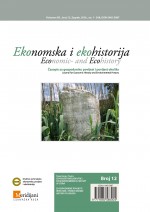Utjecaj turistifikacije na fizionomijska obilježja krajobraza unutrašnje Istre
The Impact of Touristification on Physiognomic Features of Central Istria Landscape
Author(s): Nikola VojnovićSubject(s): Rural and urban sociology, Economic development, Transformation Period (1990 - 2010), Tourism
Published by: Društvo za hrvatsku ekonomsku povijest i ekohistoriju - Izdavačka kuća Meridijani
Keywords: Inland Istria; Municipalties and towns; Tourismification; Landscape; Tourism Accomodations;
Summary/Abstract: The inner part of Istria, a relatively new tourist region, in the last ten years recorded a large increase in tourism. In the period 2001 - 2010 the number of beds tripled, the number of tourist arrivals increased by 103% and overnight stays by 125%. Intensive construction of accommodation facilities that preceded and followed this kind of tourism development has brought about in the professional and scientific community a series of disputes and controversies. The paper aims to analyze the touristification impact on physiognomic features of central Istria landscape. In the study, the author used methods of a complex field research followed by mapping, photographing and interviewing local community representatives and experts, followed by analysis of statistical data. The commercial tourist facilities were located in 225 of the 456 settlements in the hinterland; the analysis of tourism operating indicators (TOI) found that only the city of Buje and municipality Oprtalj had prevailing tourist activity (TOI 4), while all other municipalities and cities recorded lower value of this spatial concentration indicator. The inner Istria is characterized by individual accommodation facilities with a small number of beds, while the hotels are found in only six of the towns, this being a result of the previous stages in the life cycles of destinations. Individual objects are extremely spaciously dispersed, and can be divided into four basic groups: traditional Istria rural homes integrated into the existing landscape of the settlement; pseudo-traditional homes with different levels of impact on the physiognomic features; modern one-storey family houses; and housing/tourism apartment blocks. The most significant impact on physiognomic landscape components have residential/tourist villages, typical of the settlements in the area of Buje and municipalities of Sveti Lovreč, Svetvinčenat, Višnjan and Vižinada. Despite intensive development of tourism, the constructions that followed did not upset the physiognomic features of the landscape of central Istria.
Journal: Ekonomska i ekohistorija - Časopis za gospodarsku povijest i povijest okoliša
- Issue Year: 2016
- Issue No: 12
- Page Range: 44-57
- Page Count: 14
- Language: Croatian

